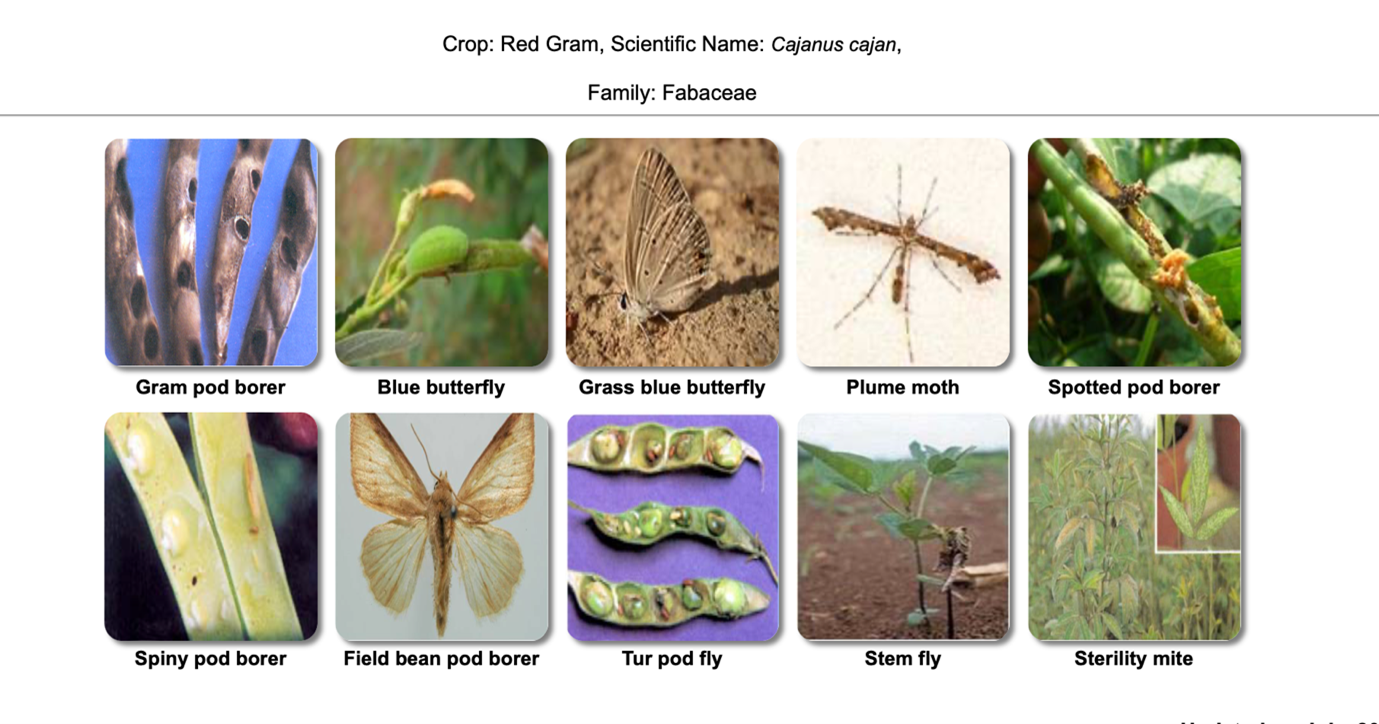Pigeon pea insect pests and their management
Pigeonpea (Cajanus cajan) is susceptible to several insect pests that can damage the crop. Here are some common pigeonpea insect pests and their management strategies:
The major pests of pigeonpea are:
- Gram pod borer (Helicoverpa armigera) – Symptoms of damage are, at early stages of crop growth, defoliation can be observed; typical symptom of the pest is larva’s head alone thrust inside the pods and the rest of the body hanging out. And affected pods with round holes can be seen. The pests will be present in all the stages: Egg, Larva, Pupa, and Adult.
- Blue butterfly (Lamides boeticus): Holes can be observed in the infested buds, flowers, and young pods. The slug-like caterpillar can be easily found, and the honeydew secretion can attract ants.
- Grass blue butterfly (Euchrysops cnejus): Buds, flowers, and young pods with holes can be observed, and slug-like caterpillar can be observed. The larval entry hole on the pod is plugged with excreta. This pest is present in Larva and adult form.
- Plume moth(Exelastis atomosa): Typical symptoms are the pin head size holes on pods and small spiny caterpillars and pupae seen on the pods.
- Spotted pod borer (Maruca testulalis): Bore holes can be observed on the buds, flowers, or pods. A typical symptom of this pest is infested pods and flowers are webbed together.
- Spiny pod borer (Etiella zinkenella): characteristics symptoms are dropping of flowers and young pods. Older or matured pods are marked with a brown spot where a larvae has entered.
- Field bean pod borer (Adisura atkinsoni): this pest’s larva bores inside the pod and feeds on the seeds within.
- Red gram pod fly (Melanagromyza obtuse): Dark brown encrustation on the pod wall. Dry pods showing pin head size hole. Seeds will be shriveled, striped, and partially eaten after the pest attack.

Control measures for the above-mentioned pests:
- Growing Sunflower as intercrop for every 9 rows of Pigeonpea crops and planting Maize crops as a border crop
- Putting Pheromone trap at least 12 /ha
- HaNPV 3’1012 POB/ha in 0.1% teepol
- Applying any one insecticides- Azadirachtin 0.03% WSP 2500-5000 g/ha; Dimethoate 30% EC 1237 ml/ha; Emamectin benzoate 5% SG 220 g/ha
- Avoid dense and close planting.
- Avoiding early or late sowing, therefore, planting should be done on time.
- Application of Carbaryl 50 WP@ 1000kg/ha
- Deep summer plowing in 2-3 years to eliminate quiescent pupa
- Adaptation of early sowing, short-duration varieties
- Avoid dense planting
- Collect and destroy larvae and adults to the extent possible.
- Installation of pheromone traps at a distance of 50 m @5 traps/ha for each insect pest
- Growing tall sorghum as a biological bird perches
- Application of NPV 250 LE/ha with teepol 0.1% and Jaggery 0.5% thrice @ 10-15 days intervals commencing from the flowering stage
- Application of any one of quinalphos 4D or Carbaryl 5D @ 25kg/ha
Stem Fly (Ophiomycia phaseoli):
The symptoms are drooping and yellowing of the tender leaves. Young plants are more sensitive and can be seriously damaged. The stems where maggot and pupae are present become swollen and start ribbing. Older plants show stunting but do not usually die. The pest will be present as eggs, larvae, and adult forms. Predominantly, the adult causes the damage.
Control measures:
- Conserving natural enemies like Euderus lividus, Edurytoma sp., Euderus agromyzae
- Seed pelleting with chlorpyriphos @ 4ml/kg of seed may reduce the stem fly population
- Spray Carbaryl 50 WP 1.5 kg 700 L water per ha
- Soil application of carbofuran 3G @ 15 kg/ha at sowing time
- Spay Imidacloprid 70% WG 500 ml/ha a week after germination and second seed round 10 days after the first application round or NSKE 5%
- Timely sowing can also minimize the attack of the pest
Red gram sterility mite (Aceria cajani):
The infected plants develop light green or chlorotic leaves with mosaic patterns. Most infected plants do not bear flowers. The eggs of the mite will present on the leaves, and the adult can be challenging to see with the naked eye and are usually found feeding on the underside of the leavws.
Control measures:
- Use of tolerant/resistant pigeonpea varieties
- Spray dicofol 18.5 EC 1.0 L or wettable sulphur 40 WP 3.0 kg or dimethoate 30 EC 1.0 L in 700 water per ha
- Avoid synthetic pyrethroids as they cause resurgence after repeated spray
References:
https://agritech.tnau.ac.in/agriculture/CropProduction/Pulses/pulses_redgram.html
Faujdar Singh and D.L. Oswalt, Pest management in Pigeonpea, 1992. International Crops Research Institute for the Semi-Arid Tropics Patacnheru, India.
O.P. Sharma, J.B. Gopali, Suhas Yelshetty, O.M. Bambawale, D.K. Garg and B.B. Bhosle, 2010, Pests of Pigeonpea and their Management, NCIPM, LBS Building, IARI Campus, New Delhi-110012, India
Kerketta, Dharmpal & Yadav, Ramesh & Keval, Ram & Painkra, G.P.. (2018). Pigeonpea and Integrated Pest Management.
http://www.agritech.tnau.ac.in/crop_protection/crop_prot_crop_insect_pul_red%20gram.html
Further reading
Pigeon pea: Plant information, History, and Nutrition
Principles of selecting the best varieties and hybrids for Pigeon pea cultivation
Pigeon pea Soil requirement, Soil preparation and Plant density
Irrigation requirement for Pigeon pea Cultivation
Fertilization requirement for Pigeon Pea
Weed Management in Pigeon Pea Farming
Pigeon pea Diseases and Management Practices
Pigeon pea insect pests and their management










































































